CT (computed tomography) contrast-enhanced kidney is a modern method that is used when it is necessary to examine the human body. For such studies, special dimensional devices are used - tomographs.
The patient's body is placed inside. Thanks to the tomograph, it is possible to perform layer-by-layer scanning. The unit itself was developed back in 1927. and was designed to research objects without the need to destroy them.
CT involves the use of weak X-rays, recording the difference between the radiation of the apparatus itself and the human body. After processing, the doctor receives a three-dimensional image of a specific part of the patient's body and can study it in detail. At the same time, you can easily determine the presence of seals or other anomalies in the examined organ.
There are several types of tomography of this type:
-
Spiral. Such equipment contains an X-ray tube, which, after placing the patient in the device, begins to rotate non-stop around him. In this case, the table on which the person is lying gradually moves deeper and deeper into the apparatus.
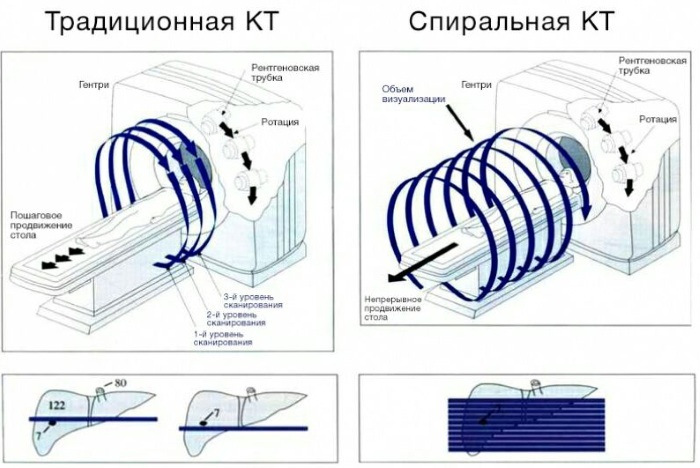
- Multi-spiral. In this case, not one radiation source is used, but much more (there can be up to 640 of them). This type of equipment allows you to study the work of the body in real time (for example, the heartbeat).
- With two radiation sources. This is one of the newest research methods that appeared in 2005. The equipment allows you to assess the condition of moving parts of the body and organs.
There is no clear cost for CT services. Therefore, it all depends on the specific medical institution. In the clinic you can get a referral for a free tomography.
Alternatively, you can go to a medical center that works on a paid basis. In this case, a standard study without the use of a contrast agent will cost about 4500-5500 rubles. If contrast is used, then the study will cost more - from 9,000 to 14,000 rubles.
Record content:
- 1 Advantages and disadvantages
- 2 Indications
- 3 Contraindications
- 4 What examinations need to be done
- 5 Training
-
6 Procedure step by step
- 6.1 How is a CT scan done on a child
- 6.2 Feelings of the patient during the procedure
- 7 Recovery after
- 8 How long will the result last
- 9 Possible complications
- 10 Kidney CT Videos
Advantages and disadvantages
Before proceeding with the procedure, it is worth considering its pros and cons.
| Benefits of CT | Disadvantages of CT |
| Painlessness | The use of X-rays, which, even in small doses, can still adversely affect human health |
| The ability to obtain a quick research result | To perform this procedure, it is required to introduce a special contrast agent into the human body, to which the examined person may have an allergy. |
| Clarity of the resulting image (all pathological changes in the examined organ or body part are visible) | CT activities are not performed for children under the age of 7-10 years due to the risk of negative effects of radiation, to which the child's body is more susceptible |
| The method is non-invasive, the patient remains conscious throughout the study, which means there is no additional burden on the heart | Increased requirements for the qualifications of doctors (it is difficult to find a truly specialized specialist) |
| After the procedure, the patient does not need recovery time or a course of medications to restore the body's strength | |
| The scanning process takes from 20 to 120 minutes | |
| There may be metal objects on (or inside) the patient's body | |
| The ability to obtain information about the presence of hidden diseases that do not manifest themselves in the form of symptoms |
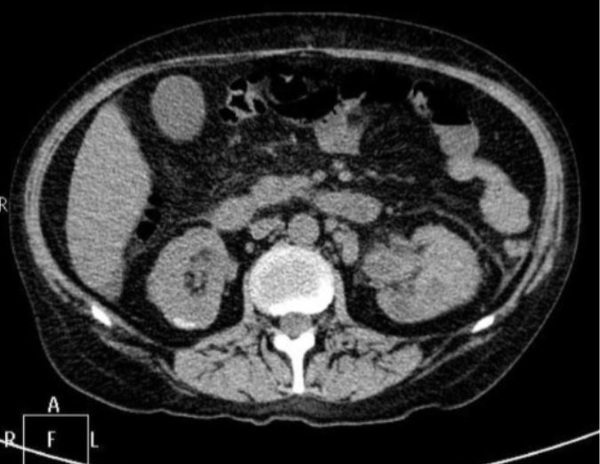
As you can see from the table above, this research method has more advantages. CT is also considered a safer test than MRI. Today, such surveys are carried out more and more often due to the high information content of the data obtained.
In addition, allergic reactions in patients are extremely rare. Usually everyone tolerates the procedure very well, without any complaints. Also, there is no need to lie still during the examination. The patient can move slightly to get a more comfortable position.
Indications
The decision on the need for a CT scan is made by the attending physician. As a rule, this type of examination is carried out if, after other standard tests and analyzes, it is not possible to make an accurate diagnosis. CT also helps if there are suspicions of several pathologies at once.
Most often, research is prescribed if the patient suffers from:
- internal injuries (due to a strong blow);
- kidney infections;
- cysts or if you suspect the development of a tumor in the kidney;
- congenital or acquired anomalies affecting the urinary system;
- hydronephrosis.
Also, similar measures are performed if the patient has had a kidney infarction and the state of this organ is being monitored.
Contraindications
CT of the kidneys with contrast implies the use of radiation, although not strong, but still. Therefore, if the patient has contraindications for examination using X-rays, then CT is not performed. Contrast also has contraindications.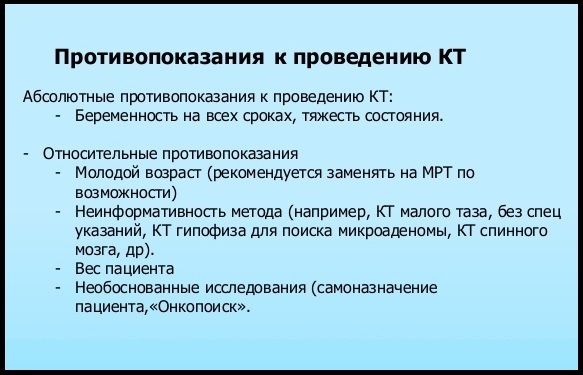
For example, it cannot be entered:
- pregnant patients (the period of gestation can be any) and those who are breastfeeding;
- children;
- patients suffering from mental disorders (for example, if the person is claustrophobic or may behave unpredictably);
- those who suffer from diabetes mellitus, problems with the thyroid gland, kidney, liver or heart failure;
- patients diagnosed with bronchial asthma;
- if a person's weight exceeds 120 kg (in this case, the patient simply cannot physically fit into the apparatus);
- if there is a pacemaker in the body;
- if a plaster is applied to the area that needs to be examined (in this case, glare and darkening will appear on the images, which will not allow an accurate diagnosis);
- if the patient is in an unconscious or extremely serious condition (the exception is emergency situations when the patient will definitely die without CT);
- if you are allergic to iodine and other contrast components;
Even if there are no serious contraindications, contrast tomography is often not recommended. In this case, there is a risk of receiving too high a radiation dose. Therefore, between CT studies, you need to take a break of about 6 months.
What examinations need to be done
CT of the kidneys with contrast requires not only preliminary preparation, but also additional examinations, which are carried out immediately before the tomography.
For example, in 4-5 days, the patient must pass a blood test (the concentration of creatinine is checked), as well as the Reberg test (an assessment of the state and functionality of the kidneys themselves). If all analyzes confirm that the patient can have CT with contrast enhancement, then the preliminary examinations are completed.
If any of the tests raises doubts in the doctor (for example, with creatinine more than 130 μmol / l), then you will have to undergo additional measures for drug preparation. Often in such situations, the patient is prescribed prophylaxis aimed at increasing the efficiency of the kidneys, as well as the thyroid gland.
The cost of tests will be approximately 100-150 rubles, if we are talking about a private clinic. In a government agency, all necessary tests and samples can be donated free of charge.
In case of abnormal values of the Roberger test, hydration of the body is required. This procedure involves the administration of saline.
Training
Preparation before CT scan can be early or late. In the first case, the patient first undergoes a standard examination by a doctor and takes the necessary tests. During the preliminary examination, the specialist decides if there are any contraindications to the procedure.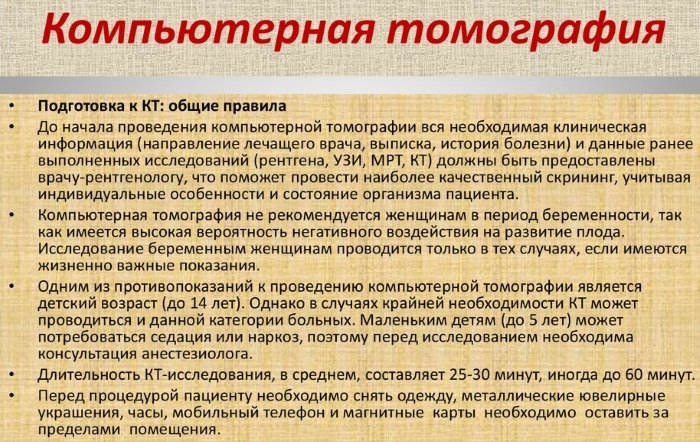
They can be relative or absolute. The last type is severe allergies. With a relative contraindication, it is possible to perform CT if the patient undergoes a course of drug therapy.
2-3 days before the tomography, the patient must adhere to a special diet. First of all, he must eat foods that do not increase, but decrease gas formation or the fermentation process in the stomach.
This means that during this period you cannot eat fresh bread, pastries, vegetables and fruits. It is necessary to abandon any greens, exclude legumes, dairy products, sweets, carbonated drinks from the diet. You also shouldn't drink alcohol.
Additionally, the doctor may prescribe a sorbent (for example, Smecta or Sorbex). These drugs are guaranteed to reduce gas production, so the risk that the study will be carried out incorrectly is eliminated.
However, there are situations when a patient does not have the opportunity to prepare for a CT scan in advance. Such preparation is called late. In this case, 4-5 hours before the examination, the patient should refuse any food and drink.
Before the procedure, the doctor must tell the patient in detail what will happen. Although it is allowed to have metal objects in the body or on the body during CT, it is advisable to remove all jewelry. Also, the doctor will have to read the analyzes again and confirm that the patient is admitted to the CT scan.
Procedure step by step
CT of the kidneys, which is performed with contrast, is carried out in much the same way as an examination without the use of an iodine-containing substance.
The procedure includes several stages:
- First, the patient must take a horizontal position on his back on a special couch. Depending on the organ being examined, the doctor may ask you to lie in a different position.
- At the next stage, the staff of the medical staff carefully slide the couch with the patient into the CT machine and go to a separate room, from where they will manage and control the images obtained.
- After 30 minutes, the medical staff pulls out the couch, and the device itself is temporarily turned off.
- After that, the doctor clarifies how the patient feels, checks if he has signs of an allergic reaction to iodine and the contrast agent itself.
- If all is well, then an X-ray contrast agent is injected into the patient's ulnar or femoral vein. For this, an automatic injector is usually used.
- Next, the doctor monitors the patient's reaction for several minutes. The patient may experience some discomfort from the administration of the drug. This is considered the norm. Also, some painfully tolerate any injections.
- When the patient is stabilized, the couch is pushed back into the CT machine.
- While the patient is in the tomograph, the x-ray tube begins to rotate. The image is being transferred to the computer.
- At this time, in the next room, the doctor carefully monitors the process and the patient's condition, who must try to breathe evenly and not move unnecessarily.
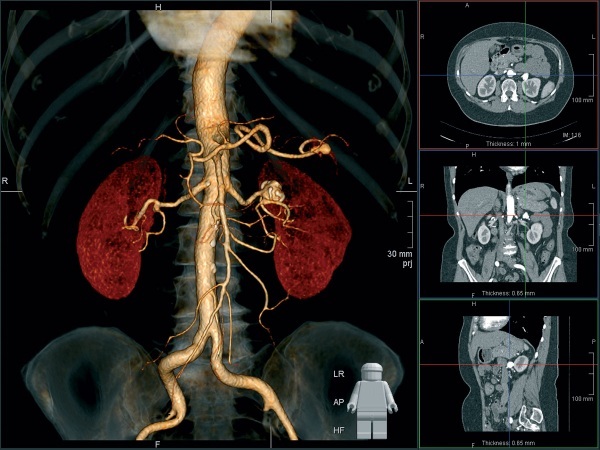
CT kidney with contrast and 3D model
Sometimes the doctor will even allow the patient to sleep during the exam. In some situations, you need to hold your breath for 5 seconds to get a clearer image of a particular angle. The patient hears all commands and recommendations through a speaker located directly in the tomograph chamber itself. The doctor uses a microphone installed in the room where she is with the nursing staff.
When the examination is over, the medical staff pulls the couch out of the scanner and helps the patient to get up. The doctor evaluates his condition. Typically, patients feel well and do not need help.
The results of the study are ready in 1.5-2 hours. All data is saved electronically and also printed as snapshots.
How is a CT scan done on a child
If there is an urgent need to conduct such a study for a child, then the young patient is placed on a standard couch for adults. The difference will be in the reduced radiation intensity on the child's body.
Children are also encouraged to follow all preparatory guidelines. Additionally, the doctor may prescribe an enema, which is performed immediately before the examination. The day before, the child needs to be given a mild laxative, which the doctor will prescribe.
Contrast-enhanced renal CT is rarely used for children under 7-10 years of age. But if without such an examination there is a danger to the patient's life, then tomography is performed. Since it takes quite a long time, the child will not be able to stay in one position for a long time.
Therefore, small doses of general anesthesia are used. In some clinics, tomographs are equipped with screens on which you can watch cartoons and films. If the child is looking at the monitor with enthusiasm, then anesthesia may not be required.
Feelings of the patient during the procedure
It is considered absolutely normal if:
- The patient feels a slight discomfort from the fact that he needs to be practically stationary in a closed chamber.
- In the process of administering a contrast agent, a sensation of heaviness and at the same time of warmth appears. Feels like the drug moves through the vein. A metallic taste may appear in the mouth. Also, for the first 2 minutes, there will be a feeling that the bladder is full. However, this feeling passes very quickly.
- During the scan, a buzzing sound is heard in the scanner, which can cause hearing discomfort.
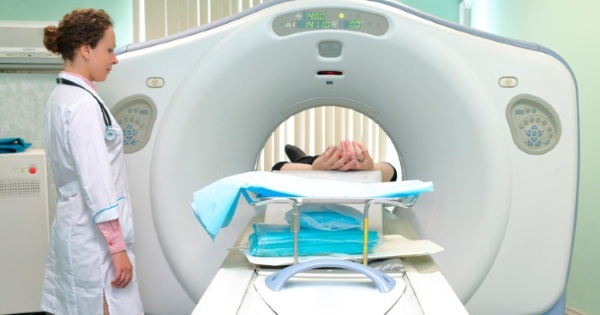
If the patient becomes scared or feels severe discomfort during the scan, do not hesitate to see a doctor. He perfectly hears everything that the patient says and will be able to calm or even distract with a conversation.
Recovery after
There are so-called side contraindications to CT. For example, if there is a risk that after the examination, the patient will experience severe discomfort. In such a situation, the doctor may prescribe 1 mg / kg / hour of saline., which is placed with a dropper. The procedure is performed 4 hours before the CT scan and within 8 hours after the examination.
It is also recommended to drink at least 1.5 liters of liquid during the day after CT scan with construction. This will speed up the process of removing the iodine-containing agent from the body. This is necessary so that the drug does not have a negative effect on the kidneys.
You should not drive for an hour after the procedure. The patient may have a sluggish response and distracted attention. However, as a rule, 40-60 minutes after the procedure, the patient is still in a medical institution under the supervision of a doctor. Very often, after 1-2 hours, the test results are ready, and the doctor talks with the patient about the subsequent treatment.
The research results are issued personally to the patient. More precisely, he receives a written opinion with all the indicators and registered violations in the work of the kidneys. In some private institutions, clients are given a CD with a CT scan. In government agencies, the patient usually receives a printed image.
These are the only possible complications of the recovery process. In all other situations, the patient after a CT scan can go home on their own.
An exception is the situation when the patient shows signs of an allergic reaction during or after the examination. For example, skin irritation could appear. In this case, the doctor can observe the patient for several more hours. If there is no deterioration, then the patient also goes home.
How long will the result last
CT of the kidneys with contrast allows you to obtain the clearest data, however, due to the contrast medium and the X-rays used in scanning, this type of procedure is not recommended to be performed more often than 1 time in six months.
As a rule, the first CT scan is sufficient to obtain all the data. If the doctor is still not sure about the diagnosis, then he refers the patient to a number of other studies that do not imply the use of X-rays.
CT causes pathological reactions in 1-3% of patients. They indicate that the next study of this type should only be carried out in an extreme situation.
Such symptoms after the procedure include:
- severe swelling of the face;
- shortness of breath that does not go away for a long time after CT;
- hives on the body or rash;
- severe itching of the skin;

- the appearance of bronchospasm;
- lowering blood pressure;
- the appearance of nausea and vomiting and other allergic reactions.
Possible complications
Contrast-enhanced renal CT is a procedure with minimal risks to the patient's health. During the study, the person experiences only minor discomfort. No rehabilitation or recovery with medication is required.
The most dangerous complication, which is observed in isolated cases, is an allergic reaction. The patient may have a swollen lip, severe skin irritation, or itching. All these symptoms are quickly relieved by taking antihistamines.
Also, complications sometimes arise with the introduction of contrast. For example, if a person has very sensitive and thin skin, it is more difficult for him to tolerate a puncture.
If a patient has to undergo several examinations using CT (and there is no urgent need for this), then there is a risk that radiation will begin to accumulate in the tissues of the body. This can provoke cancers. This rarely happens, for example, if the patient does not inform the doctor about previous examinations.
Iodine-containing substances that are injected for contrast are not dangerous in themselves, but only if the kidneys are working normally. In this case, the liquid has no harmful effect.
But with renal failure, the drug will be excreted much longer, which can provoke damage to the renal tissues. In the most difficult situations, patients are diagnosed with tissue necrosis. However, this is possible only if the doctor has not noticed such a serious disease, which is an absolute contraindication to CT.
Kidney CT is a safe procedure if it is done properly. Therefore, it is very important to pass all tests before undergoing a study with contrast enhancement. The doctor must be sure that the patient does not have any serious contraindications to tomography.
Kidney CT Videos
About kidney research:


